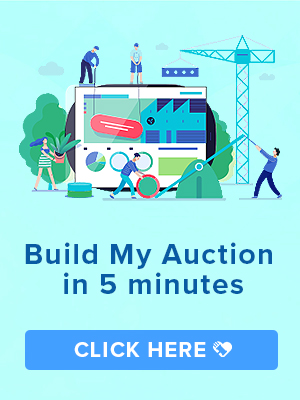
An efficient and fun way to raise money for organizations, the silent auction is a favorite of both fundraisers and donors. It’s no wonder that so many non-profits hold them annually.
Still, to run an effective silent charity auction, you need to know the ABCs of silent auctions. Not to worry, as we are here to help! From planning a silent auction to promoting it, running it, and collecting your funds at the end of it, we can tell you everything you need to know about running a successful silent auction.
What is a Silent Auction?
If you’ve ever seen a live auction, you know it can be loud and dramatic, as the auctioneer calls for higher and higher bids and attendees continue to yell out their dollar amount or raise their paddles on an item. A silent auction is the quiet version, where bidders put their bids down on a sheet of paper, or, more commonly today, on a bidding website or app. The highest bid wins and the proceeds go to the organization or cause.
A silent auction is a great option for a live event where you might be having dinner, dancing, speeches, or performances. The silent auction can happen in the background and winners can be announced at the end. This type of auction might encourage more people to bid, too, if they’re too shy to do a live auction, or, if they don’t want to disclose publicly what they’re willing to spend on an item (you don’t have to announce the winners or their winning bid, after all).
Not only do attendees have lots of fun while bidding on items, but they also donate to a worthwhile cause, hence fostering a strong sense of community. Silent auction fundraisers don’t have to be associated with a live event either: you can have them at any time for any reason, to solicit bids and donations separately from a function that might take a lot of upfront cash to put on. We’d say that it is a win-win.
In-Person vs. Online Silent Auctions
Not only can your silent auction take place online, but thanks to silent auction software like ours, there are multiple new ways you can organize silent auctions to enlarge the pool of bidders and raise more money. For example, you can organize:
- Traditional silent auction offline, in-person with bid-sheets
- Silent auction, in-person supported by a platform like CharityAuctionsToday that enables bidding via smartphone (mobile bidding)
- Silent auction, fully online via a platform like CharityAuctionsToday
- In-person silent auction with additional remote bidders supported by a platform like ours – the gold standard that allows for the most bids to come through
Unsure if an online silent auction is the right option for your organization? Take a look at our article on the benefits of running a silent auction online. A mobile bidding software like ours can make your life easier by saving you time: you can also check out our comparison of different online auction platforms to see which might work best for you.
You can, of course, go old-school and organize an in-person live auction using paper bid sheets. That being said, this type of event requires more work from the organizers. There are also physical and audience limitations that you will need to consider. For example, an in-person silent auction will restrict participation to only those present at the event, and your in-person event space will be limited by a budget. Unfortunately, paper bid sheets are also much easier to cheat on than an online auction platform.
We’ll walk you through how to organize both traditional and online auction events, and point out the differences, so you won’t miss any details.
How to Run a Silent Auction
Like any event, a successful silent auction depends on an airtight planning process. No matter how big or small your budget is, your silent auction will be a success as long as you respect some steps. From creating the auction committee and soliciting silent auction items to determining bidding rules, these are just some stages our step-by-step guide will walk you through.
1. Create an Auction Committee
While a small committee of five leaders is preferable, you will need as many helping hands as possible. Working with volunteers will not only lighten the workload but it will also make the experience more enjoyable.
Once you have chosen a group of dedicated individuals, you will need to assign leadership roles. Below is an overview of the key positions: but of course, if you don’t have the people for all of them, or if you’re flying solo on all of this, take heart! We’ll cover ways to make this process as simple as possible.
- Planning: From establishing the date, time, and budget for the event to working with outside parties to run a silent auction, this person or group will oversee every aspect of the planning process.
- Prizes: Audience members will donate more when prizes are exciting, so getting the right gift donations or writing compelling item descriptions can increase a silent auction’s success. Essentially, the prize leader and volunteers are in charge of asking for donations and negotiating sponsorships.
- Publicity: Spreading the word is vital to the success of your silent auction. From raising awareness through social media posts and speaking to the local press, to designing flyers or networking, the publicity team is in charge of encouraging interest in your silent auction.
2. Ask for Donations & Silent Auction Items
How do you find the right types of prizes to thrill the audience? How do you foster a sense of community with the prizes and sponsorships? How do you structure the auction for maximum bid potential?
First, you need to know your target audience. Encourage your committee to think about your attendees and start a brainstorming session. Who is already affiliated with your organization? Who’s not, but could be interested in your cause? Who’s affiliated with the businesses and other organizations you want to partner with? Then, start thinking about prizes:
- Look for a range of items priced from low to high as you want everyone to feel comfortable bidding. Keep in mind that gift baskets are generally crowd-pleasers because they can work for various budgets.
- Have a wide variety of prizes to choose from. Prizes should be as diverse as your audience. For example, gifts like board games or water park tickets will be a hit for families. On the other hand, couples’ gifts like spa days or golf outings will always be popular.
- Incorporate kid-centric gifts so that you can include the kids in the festivities. From one-on-one experiences with a teacher to a game from a local toy store, these auction items can bring in lots of bids and foster a sense of community.
- Ask your team to reach out to their personal network. Perhaps they frequent a great local restaurant that would donate dinner for two at the chef’s table, or maybe they have a friend from college who can score great tickets to a hot Broadway show.
- Contact local business owners regarding donations. Most business owners are accustomed to being asked to participate in local fundraising efforts and are happy to donate. In exchange for their donated items, you can offer free publicity during your marketing campaign and at the event itself.
We understand it can feel awkward to ask for items and prizes: be sure to explore our tips on how to ask for donations to boost your confidence.
What Is and What Isn’t a Great Silent Auction Item
As previously mentioned, you’ll want a variety of items that are as diverse as your audience. The more varied your prices and products are, the higher your chances of success.
Here are some of the auction items that always sell:
- Experiences: One-of-a-kind events like tours of pro teams’ locker rooms before big games or backstage passes for hit shows always create a buzz.
- Travel: Vacations, weekend trips, or even full-day trips are a hit at almost every silent auction. Want to add unique travel experiences to your auction? Then, check out our risk-free items that can be added for free.
- Tickets: Day passes to amusement parks, concert tickets, or spa days always create a buzz.
- Unusual Items: Auction items like signed memorabilia or Broadway posters are always fun to display at an event and can really draw people into the bidding.
Here are some donated items to avoid during a silent auction:
- Used (or broken!) items
- Clothing
- Furniture
Hot Tip: Got your items? You can start building your auction right now, even if you don’t have all the details set in stone. Get your auction started for free!
3. Set the Date and Place
Then, you will need to determine the time and date. If you intend to host your event in person, you will need to find an appropriate and affordable space. In general, school auditoriums and cafeterias are perfect for such silent auction fundraisers. However, if you’re social distancing, you might look at outdoor venues or online options. Fancier venues will stretch your budget even if you work out discounts with the hotel or banquet hall.
Here are some questions you should ask yourself before choosing a venue for your auction:
- How many attendees are expected?
- Is there enough room to display the auction items aesthetically?
- Do you intend to create a certain atmosphere?
- Is there good mobile and/or Wi-Fi connectivity available so that silent auction software and mobile bidding can be used?
Tip: Whether you are doing a school fundraiser or not, check with your nearest school and see what spaces they have available. Depending on the event, they will often rent or even donate the space.
Here you have some advice on how to choose your auction venue:
- Find a place where doors can be locked or hire security.
- Check if the room is large enough for your guests to circulate freely, especially around auction items.
- Ensure that their facility rules won’t interfere with your event plans, such as mandatory end times, noise limits, alcohol restrictions, etc.
4. Choose an Activity or Entertainment
If you want your attendees to be engaged and entertained throughout your silent auction, you need to make it fun. If your event is not a sit-down dinner gala, you can still plan to keep people’s interest with ideas like these:
- Music from a live band
- A master of ceremonies beckoning them to grab a drink and join the fun
- A raffle table with a bonus goodie or two that anyone can win
- Great food set up on tables or being passed by waiters among guests
- Beautiful flower arrangements from a local florist that they can win
- A projection screen showing sweet and funny images of your beneficiaries
- Beautiful silent auction tables laden with tempting bid items
5. Promote the Silent Auction
You’re championing a cause you’re passionate about. You’ve formed a committee and planned meticulously. Now you need to actively market your event to get people to attend and raise funds. Here are a few ideas to promote your next silent auction:
- Request Sponsorships from Media Outlets: Many media groups will provide free promotion for your event in exchange for sponsor recognition. You can guarantee that their logo will be placed on all promotional materials in exchange for an ad. Make sure they’re present in social media posts when possible and include them in all follow-up materials, especially the ones that celebrate reaching your goal and funding your cause.
- Send Out Press Releases: A press release is a detailed account of your event that presents important information in an objective rather than a promotional manner. It should include your story, some compelling images, and even an embedded video.
Leverage Social Media and Maximize Your Fundraising Profits
A must for event promotion in today’s connected world, social media can maximize engagement and dramatically boost your fundraising efforts. In fact, our four tips will help you enhance your organization’s social media presence:
- Tell Your Story: Stories foster empathy and help people connect to your cause. In a few sentences, summarize your story and post it on social media.
- Post Shareable Content: Shareable posts increase your organization’s visibility. Set privacy settings to “global” or “all” if you are sharing from a personal account so everyone can share your posts. Still, you need to give your followers a reason to want to share your content. For example, you could post about the cause, the event itself but also about who will be there or what special activities will take place.
- Give a Call to Action: Tell your audience explicitly what you want them to do. (i.e., “Please support our school by sharing this on your timeline”)
- Create a Sense of Urgency – People act quickly when they know there’s a deadline. When it comes to online auctions, you can encourage your followers with phrases such as: “Auction ends in two days.” or “Don’t miss out on this is a one-of-a-kind item.”
Be sure to check out our article on how you can utilize different social media platforms to boost your fundraiser (with examples).
6. How to Organize a Silent Auction
Online and traditional silent auctions are easy to run but, if you want to avoid any last-minute surprises, you should plan every step out so your volunteers know exactly what to do. Depending on the type of charity auction you are organizing, the requirements will vary.
If you’re holding an in-person silent auction:
- Establish the answers to these questions: Do we have a guest list? Do we need to assign bidding numbers? Do we have a predefined checkout process?
- Arrange auction tables in the center of the space to facilitate maximum exposure. Give each prize some room so nothing gets lost, visually speaking. About 6-12 inches between each prize is ideal.
- Determine starting bid amounts, bid increments, how bidders will place bids (bid sheet or mobile bidding), and set any auction rules.
- Prepare bid sheets with the name of the item (at the top of the sheet list, in bold), a short description of the auction item (its value, minimum bid amount, etc.), the donor’s name, and a series of numbered, blank lines where people can write their bidder number and bid amount
Preparing bid sheets is a lot of work and they must be double and triple-checked to catch errors throughout the bidding period and after. With charity auction software like CharityAuctionsToday, you create the auction, add the items, and the winner of the auction is decided and billed automatically. Simple as that.
Whether your event is in-person or online-only, follow these best practices:
- Create group packages: Packaging, or grouping, prizes increases the perceived value, so donors feel free to give more. However, this only works if you create packages that make sense. For example, group the restaurant gift certificates with a bottle of wine and a pair of theater tickets for The Ultimate Date Night.
- Create visually-appealing prize descriptions: Make sure the description card is uncluttered and has a balance of pictures and words. The item description sheet should include: the item name and number, a brief description, the market value, and the starting bid.
- Write descriptions for attendees: You should write in such a way that helps attendees envision themselves using the prize. Take this Mother-Daughter mani/pedi description as an example: “Treat yourselves to a spa day that will leave you feeling refreshed and polished.”
- Determine Silent Auction Rules: If you want to enhance the donors’ experience and simplify the donation process, bidding rules are a must. Here are some rules you might want to set for a smooth bidding experience:
- Bidders can only bid up from the previous bid.
- Bids that have been changed or crossed out must be initialed by the bidder.
- No bids will be accepted after the auction ends.
7. How to Close a Silent Auction
Closing your silent auction bids, either online or in-person, may seem straightforward, but there are a few things to consider that can maximize your fundraising efforts right at the end of your event.
There are three types of bidding closings that you can choose from:
- Spontaneous closing: Not knowing when the bidding will end, creates a frenzy of activity among bidders that makes them put their best bids in and stay at the top of the bid sheet. If you want to add some thrill to your event, this is the closing for you.
- Pre-planned closing: This type of closing creates a slow build of action throughout the event. If you plan on closing the bidding at a designated time, we suggest having a countdown clock visible or sporadic “countdown” reminders from the auction chairs. Get ready for some last-minute bidding wars as the last few minutes of the silent auction will be intense.
- Staged closing: Closing the bidding for each category of prizes, one by one, can make the auction feel more exciting as the number of items to bid on gets smaller and smaller. Staged closings work best when you group prizes into categories, as naming the categories will help attendees follow along with your plan.
No matter the closing you choose, make sure you make it memorable. For in-person silent auctions, committee members should immediately collect the bid sheets and announce the winning bid for each prize.
For online auctions, on the other hand, the silent auction software will confirm the winning bids and notify the winner and the competing bidders. Moreover, since the auction software gathers bids and payment details for the auction items, it will be easy for you to process payments.
8. Raise Awareness after Your Event
Your job doesn’t end after you close your silent auction. Think about it, the event is still fresh in the attendees’ minds so now is the perfect time to increase awareness, and, hopefully, get some last-minute donations.
Here are some gestures that don’t take a lot of time, but make a big difference in how your organization is perceived:
Thank Attendees and Donors
Not only does a personalized “thank you” note humanize your organization, but it can also serve as a last call for people who didn’t get to bid at the event or want to donate more.
You should send the note up to one week after the event when everything is still fresh in the attendees’ minds.
In the note, be sure to:
- Remind them of your mission
- Let them know how their donation helps
- Thank them for their donation
- Include a “thank you” video via email if you want an upgrade
- Add a link to donate in your signature (but don’t ask for a donation)
Dear [Attendee],
We did it. Together, we raised $X for [insert your mission or goal, e.g., “to buy new playground equipment for our school”]. Your participation in our event was critical, and we were so glad to see you there.
Thanks to your contribution, [organization name] can [insert what you plan to do with the funds, e.g., “help our kids get a better education”] so that [insert the problem you want to solve, e.g., “they can have a brighter future.”].
From the bottom of our hearts, we thank you for your generosity.
Share Your Thanks Through Social Media
Social media is a great way to reach many people at one time and create a buzz. A simple post is all it takes.
Be sure to:
- Tag your donors and/or attendees. Thank your sponsors too.
- Mention the reason behind the event and any reached fundraising goals.
- Include pictures, if appropriate.
- Include a link to online giving if you have one.
Ready to Run a Silent Auction?
While running a silent auction may have seemed daunting at first, executing a successful charity auction should be easy now. That being said, a silent auction software will make planning and running your event easier.
In fact, participants often find these more exciting than the more traditional method, as there is less pressure.
Nonetheless, no matter the format, organizing a silent auction is not only a fun way to raise funds but is also a great way to bring communities together



